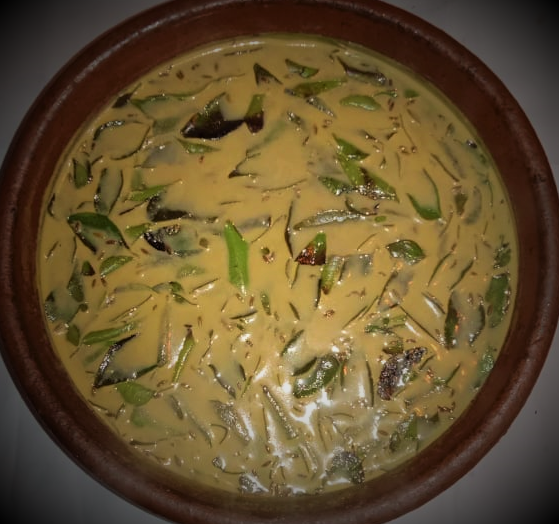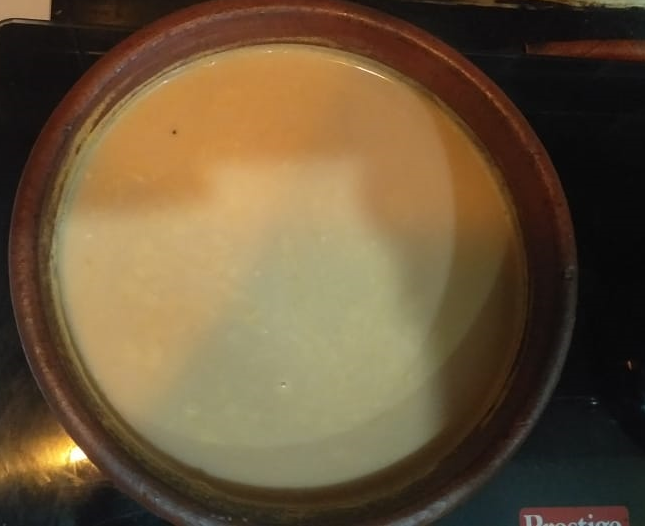Pepper Rasam (with coconut & milk)
Spiced soup
Rasam is a centuries-old heart warming soup preparation that never misses a place in a traditional Hindu Menu. It has a distinct sour, peppery and chilly taste that makes it a true repository of flavours.
Introduction
About this Recipe
Rasam is a centuries-old heart warming soup preparation from South India. It has a distinct sour, peppery and chilly taste that makes it a true repository of flavours. Rasam is either eaten along with rice or savoured after a meal. Soothing and satiating to every part, the soup is also considered to be dense in nutrition.
It is mainly made using black pepper, cumin seeds and asafoetida which makes it one of the most nutrient-dense foods. When the coconut is added along with the added spices it is a real treat to our senses.
There are many different types and variations of rasam prepared in several households. One of the most popular variants of rasam relished across the country is the pungent Pepper rasam.
Rasam is also called saar, saaru in Kannada, chaaru and pulusu in Telugu languages of South India.
It is consumed for a variety of its health benefits, especially those to do with our stomach. It is also an excellent source of minerals such as potassium, iron, calcium, zinc, selenium, copper and magnesium.
The use of black pepper in the stew helps secretion of acids that aid digestion. It also prevents formation of gas, and flatulence.
In the Bhaga Shastra there are 29 types of rasams, each varying from the other in terms of spices and flavours. In our meals among all the side dishes that go well with the rice, rasam plays a very significant role which is very good for health and a treat to our tongue. Usually, a rasam powder is prepared in and stored in an airtight container, the aroma of which can be retained for at least a week. However, astute cooks prefer to combine the spices and grind them at the time of preparing the rasam to maintain its original flavour.
Here we present the ingredients and methods as described in Bhaga Shastra. The measurements have not been rounded up for conversion and have been used as is, in order to maintain the authenticity of the Bhaga shastra. In Bhaga shastra the measurements are given in units like Palam, Padi etc. as used in ancient times. They are converted into units in grams and kilograms for everyone to understand easily.
Bhaga Shastra Units Conversion
1 Padi – 1500 gms or 1.5 kg approx
1 Palam – 35 gm approx
1 R.e (Rupee Equivalent) – 4.8 gm approx

“MY GURUS GAVE ME 2 IMPORTANT INSTRUCTIONS:
ONE CLOTH AND ONE MEAL; AND FOR THAT ONE MEAL ALSO:
Oru Soru, Oru Saaru, Oru Moru –
ONE RICE, ONE JUICE LIKE RASAM, AND ONE BUTTERMILK!”
– SPH JGM Nithyananda Paramasivam
-
Preparation time: 15 minutes
-
Cooking time: 15 minutes
-
Total time: 30 minutes
-
Servings : 20 servings
-
Course: Appetizer, a side dish that is added to rice or is had on its own
-
Cuisine: South Indian dish
Ingredients
- Water 1.6 ltr (1 padi)
- Pepper 17.5 gm (½ palam)
- Toor dal 35 gm (1 palam)
- Urad dal 8.75 gm (¼ palam)
- Jeera 8.75gm (¼ palam)
- Salt 17.5 gm (½ palam)
- Red chilli 4.4 gm (⅛ palam)
- Coconut 52.5 gm (1.5 palam)
- Curry leaves 35 gm (1 palam)
- Milk 375 ml (¼ padi)
- Ghee 17.5 ml (½ palam)
Cooking Method
- Now after 8 hours of fermenting, idli batter is ready and we have to season the batter.
- Add sesame oil in a pan. Once it is hot, put the pepper powder, cumin powder, dry ginger powder, asafoetida powder and curry leaves into the oil and fry a little.
- Add this seasoning to the idli batter and mix well.
- Next, the batter has to be poured into a container like a steel tumbler to cook the idlis, to obtain the cylindrical shape.(Traditionally, bamboo baskets are used as a mould. If these are not available, steel/brass tumblers can be used as containers for the moulds. To avoid leakage of the batter, plantain/banana & mandara leaf are used to line the bottom and inside of the tumbler/container. Use 3 mantharai leaves around the sides as well. The mantharai leaves are the traditional leaves used for this recipe and are very good for health.)
- Place the idli vessel on the stove and pour water into it. Boil the water until it comes to a steam. The idlis have to be cooked in this steam. Note: If you don’t have an idli vessel, you can use any steamer you use at home
- Now pour the batter in the moulds and place them carefully upright in the idli vessel – as many moulds as can fit into the idli vessel.
- Place a plantain leaf on the top of the moulds to cover it and then close the lid of the idli vessel.
- Allow the idlis to cook for 20 minutes. Note – cooking times may vary as per the steamer you are using.
- Use a small knife or a thin stick/toothpick to check whether the idlis are cooked. Poke the stick into one idli, if the stick comes out clean, the idlis are done.
- Then, remove the idlis from the idli vessel carefully, and place it on a plate to cool.
- Kanchipuram idlis are now ready to be served. Remove the leaf covering the idlis before serving!
Step by step instructions
1
Take 1.6 ltr. of water in a mud pot.

2
Fry the peppercorns in ghee.

3
Fry urad dal in ghee.

4
Fry the grated coconut in ghee.

5
Put all the fried ingredients in a bowl.

6
Grind all the ingredients.

7
Mix the paste in the water in the mud bowl.

8
Dry roast the curry leaves.

9
Add the roasted curry leaves into the paste and boil it for a few minutes.

10
Now the final recipe is ready for all to relish.


